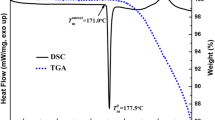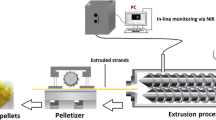Abstract
Undesired-burst release effect is observed in a freely water-soluble drug formulated into a gastro-floating formulation with effervescent (GFFE) delivery system. In order to address this limitation, interpolymer complex (IPC) of two swellable and non-soluble polymers, poly-ammonium methacrylate and poly-vinyl acetate, was incorporated into hydroxypropyl methyl cellulose (HPMC)-based matrix GFFE. This research studied the effect and interaction of the IPC-HPMC blending on the drug release of GFFE using a freely water-soluble drug, metformin HCl, under different threshold concentration levels and curing effect. The interaction between the IPC and HPMC was characterized using vibrational spectroscopy and thermal analyses under curing and swelling conditions. Anti-solvent followed by lyophilization had better physicochemical and physicomechanic properties than spray dying technique. The interaction was observed by a specific shifting of the vibrational peaks and alteration of the thermal behavior pattern. These effects altered the drug release behavior. Thereafter, the IPC reduced burst release effects in the initial time and during testing, and the IPC improved the HPMC matrix robustness under mechanical stress testing below threshold concentration of HPMC matrix formulated in the GFFE.








Similar content being viewed by others
References
Ainurofiq A, Choiri S. Drug release model and kinetics of natural polymers-based sustained release tablet. Lat Am J Pharm. 2015;34(7):1328–37.
Siepmann J, Faham A, Clas S-D, Boyd BJ, Jannin V, Bernkop-Schnürch A, et al. Lipids and polymers in pharmaceutical technology: lifelong companions. Int J Pharm. 2019;558:128–42.
Contreras L, Melgoza LM, Villalobos R, Caraballo I. Study of the critical points of experimental HPMC–NaCMC hydrophilic matrices. Int J Pharm. 2010;386(1–2):52–60.
Jain AK, Söderlind E, Viridén A, Schug B, Abrahamsson B, Knopke C, et al. The influence of hydroxypropyl methylcellulose (HPMC) molecular weight, concentration and effect of food on in vivo erosion behavior of HPMC matrix tablets. J Control Release. 2014;187:50–8.
Siepmann J, Peppas NA. Modeling of drug release from delivery systems based on hydroxypropyl methylcellulose (HPMC). Adv Drug Deliv Rev. 2012;64 Supplement:163–74.
Haque SE, Sheela A. Design and in vitro evaluation of interpolymer complex bound metformin sustained release tablet. J Appl Polym Sci. 2014;131(21):41018.
Huang X, Brazel CS. On the importance and mechanisms of burst release in matrix-controlled drug delivery systems. J Control Release. 2001;73(2–3):121–36.
Klancar U, Baumgartner S, Legen I, Smrdel P, Kampuš NJ, Krajcar D, et al. Determining the polymer threshold amount for achieving robust drug release from HPMC and HPC matrix tablets containing a high-dose BCS class I model drug: in vitro and in vivo studies. AAPS PharmSciTech. 2015;16(2):398–406.
Naiserová M, Kubová K, Vysloužil J, Pavloková S, Vetchý D, Urbanová M, et al. Investigation of dissolution behavior HPMC/Eudragit®/magnesium aluminometasilicate oral matrices based on NMR solid-state spectroscopy and dynamic characteristics of gel layer. AAPS PharmSciTech. 2018;19(2):681–92.
Elsamaligy S, Bodmeier R. Development of extended release multiple unit effervescent floating drug delivery systems for drugs with different solubilities. J Drug Deliv Sci Technol, 30 Part B. 2015:467–77.
Maghsoodi M, Barghi L. Polymer percolation threshold in multi-component HPMC matrices tablets. Adv Pharm Bull. 2011;1(1):27–33.
Gonçalves-Araújo T, Rajabi-Siahboomi AR, Caraballo I. Polymer percolation threshold in HPMC extended release formulation of carbamazepine and verapamil HCl. AAPS PharmSciTech. 2010;11(2):558–62.
Mason LM, Campiñez MD, Pygall SR, Burley JC, Gupta P, Storey DE, et al. The influence of polymer content on early gel-layer formation in HPMC matrices: the use of CLSM visualisation to identify the percolation threshold. Eur J Pharm Biopharm. 2015;94:485–92.
Mohamed FAA, Roberts M, Seton L, Ford JL, Levina M, Rajabi-Siahboomi AR. The effect of HPMC particle size on the drug release rate and the percolation threshold in extended-release mini-tablets. Drug Dev Ind Pharm. 2015;41(1):70–8.
Ali R, Dashevsky A, Bodmeier R. Poly vinyl acetate and ammonio methacrylate copolymer as unconventional polymer blends increase the mechanical robustness of HPMC matrix tablets. Int J Pharm. 2017;516(1–2):3–8.
Jeganathan B, Prakya V. Interpolyelectrolyte complexes of Eudragit® EPO with hypromellose acetate succinate and Eudragit® EPO with hypromellose phthalate as potential carriers for oral controlled drug delivery. AAPS PharmSciTech. 2015;16(4):878–88.
Zhang F, Meng F, Wang ZY, NA W. Interpolymer complexation between copovidone and carbopol and its effect on drug release from matrix tablets. Drug Dev Ind Pharm. 2017;43(2):190–203.
Ohyagi N, Ueda K, Higashi K, Yamamoto K, Kawakami K, Moribe K. Synergetic role of hypromellose and methacrylic acid copolymer in the dissolution improvement of amorphous solid dispersions. J Pharm Sci. 2017;106(4):1042–50.
Robertis SD, Bonferoni MC, Elviri L, Sandri G, Caramella C, Bettini R. Advances in oral controlled drug delivery: the role of drug–polymer and interpolymer non-covalent interactions. Expert Opin Drug Deliv. 2015;12(3):441–53.
Khutoryanskaya OV, Morrison PWJ, Seilkhanov SK, Mussin MN, Ozhmukhametova EK, Rakhypbekov TK, et al. Hydrogen-bonded complexes and blends of poly(acrylic acid) and methylcellulose: nanoparticles and mucoadhesive films for ocular delivery of riboflavin. Macromol Biosci. 2014;14(2):225–34.
Khutoryanskiy VV. Hydrogen-bonded interpolymer complexes as materials for pharmaceutical applications. Int J Pharm. 2007;334(1–2):15–26.
Zhang G, Jiang M, Zhu L, Wu C. Intermacromolecular complexation because of specific interactions 11. Ionic interaction complexation and its comparison with hydrogen-bonding complexation. Polymer. 2001;42(1):151–9.
Elzayat EM, Abdel-Rahman AA, Ahmed SM, Alanazi FK, Habib WA, Sakr A. Multiple response optimization of processing and formulation parameters of Eudragit RL/RS-based matrix tablets for sustained delivery of diclofenac. Pharm Dev Technol. 2017;22(7):928–38.
Elzoghby AO, Vranic BZ, Samy WM, Elgindy NA. Swellable floating tablet based on spray-dried casein nanoparticles: near-infrared spectral characterization and floating matrix evaluation. Int J Pharm. 2015;491(1–2):113–22.
Costa P, Sousa Lobo JM. Modeling and comparison of dissolution profiles. Eur J Pharm Sci. 2001;13(2):123–33.
Yusif RM, Hashim IIA, Mohamed EA, El R. Investigation and evaluation of an in situ interpolymer complex of carbopol with polyvinylpyrrolidone as a matrix for gastroretentive tablets of ranitidine hydrochloride. Chem Pharm Bull (Tokyo). 2016;64(1):42–51.
Zhang F, Lubach J, Na W, Momin S. Interpolymer complexation between Polyox and Carbopol, and its effect on drug release from matrix tablets. J Pharm Sci. 2016;105(8):2386–96.
Tarlier N, Soulairol I, Bataille B, Baylac G, Ravel P, Nofrerias I, et al. Compaction behavior and deformation mechanism of directly compressible textured mannitol in a rotary tablet press simulator. Int J Pharm. 2015;495(1):410–9.
Chen Y-C, Ho H-O, Liu D-Z, Siow W-S, Sheu M-T. Swelling/floating capability and drug release characterizations of gastroretentive drug delivery system based on a combination of hydroxyethyl cellulose and sodium carboxymethyl cellulose. PLoS One. 2015;10(1):e0116914.
Bansal S, Beg S, Garg B, Asthana A, Asthana GS, Singh B. QbD-oriented development and characterization of effervescent floating-bioadhesive tablets of cefuroxime axetil. AAPS PharmSciTech. 2016;17(5):1086–99.
Guo L, Sato H, Hashimoto T, Ozaki Y. FTIR study on hydrogen-bonding interactions in biodegradable polymer blends of poly(3-hydroxybutyrate) and poly(4-vinylphenol). Macromolecules. 2010;43(8):3897–902.
Varma-Nair M, Costello CA, Colle KS, King HE. Thermal analysis of polymer–water interactions and their relation to gas hydrate inhibition. J Appl Polym Sci. 2007;103(4):2642–53.
Dey SK, De PK, De A, Ojha S, De R, Mukhopadhyay AK, et al. Floating mucoadhesive alginate beads of amoxicillin trihydrate: a facile approach for H. pylori eradication. Int J Biol Macromol. 2016;89:622–31.
Gendre C, Genty M, da Silva JC, Tfayli A, Boiret M, Lecoq O, et al. Comprehensive study of dynamic curing effect on tablet coating structure. Eur J Pharm Biopharm. 2012;81(3):657–65.
Li Y, Wurster DE. The effects of curing and casting methods on the physicochemical properties of polymer films. AAPS PharmSciTech. 2018;19(6):2740–9.
Acknowledgments
This research was funded by Indonesian Endowment Fund for Education (LPDP). The authors would like to thank Evonik (Darmstadt, Germany) for providing Eudragit Polymers, BASF (Ludwigshafen, Germany) for providing Kollidon SR, Colorcon (West Point, PA) for providing Methocel K100M DC, and PT Phapros (Semarang, Indonesia) for providing Metformin HCl.
Author information
Authors and Affiliations
Corresponding authors
Ethics declarations
Conflict of Interest
All authors declare there was no conflict of interest
Additional information
Publisher’s Note
Springer Nature remains neutral with regard to jurisdictional claims in published maps and institutional affiliations.
Electronic supplementary material
ESM 1
(DOCX 159 kb)
Rights and permissions
About this article
Cite this article
Choiri, S., Sulaiman, T.N.S. & Rohman, A. Reducing Burst Release Effect of Freely Water-Soluble Drug Incorporated into Gastro-Floating Formulation Below HPMC Threshold Concentration Through Interpolymer Complex. AAPS PharmSciTech 20, 196 (2019). https://doi.org/10.1208/s12249-019-1414-z
Received:
Accepted:
Published:
DOI: https://doi.org/10.1208/s12249-019-1414-z




